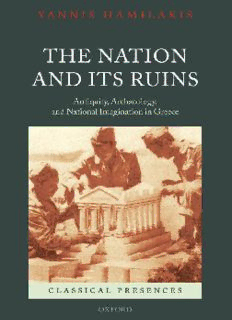
The Nation and its Ruins: Antiquity, Archaeology, and National Imagination in Greece (Classical Presences) PDF
Preview The Nation and its Ruins: Antiquity, Archaeology, and National Imagination in Greece (Classical Presences)
CLASSICAL PRESENCES General Editors Lorna Hardwick James I. Porter CLASSICAL PRESENCES Thetexts,ideas, images,andmaterialcultureofancientGreeceandRome have always been crucial to attempts to appropriate the past in order to authenticate the present. They underlie the mapping of change and the assertion and challenging of values and identities, old and new. Classical Presencesbringsthelatestscholarshiptobearonthecontexts,theory,and practiceofsuchuse,andabuse,oftheclassicalpast. The Nation and its Ruins: Antiquity, Archaeology, and National Imagination in Greece YANNIS HAMILAKIS 1 3 GreatClarendonStreet,Oxfordox26dp OxfordUniversityPressisadepartmentoftheUniversityofOxford. ItfurtherstheUniversity’sobjectiveofexcellenceinresearch,scholarship, andeducationbypublishingworldwidein Oxford NewYork Auckland CapeTown DaresSalaam HongKong Karachi KualaLumpur Madrid Melbourne MexicoCity Nairobi NewDelhi Shanghai Taipei Toronto WithoYcesin Argentina Austria Brazil Chile CzechRepublic France Greece Guatemala Hungary Italy Japan Poland Portugal Singapore SouthKorea Switzerland Thailand Turkey Ukraine Vietnam OxfordisaregisteredtrademarkofOxfordUniversityPress intheUKandincertainothercountries PublishedintheUnitedStates byOxfordUniversityPressInc.,NewYork (cid:1)YannisHamilakis2007 Themoralrightsoftheauthorhavebeenasserted DatabaserightOxfordUniversityPress(maker) Firstpublished2007 Allrightsreserved.Nopartofthispublicationmaybereproduced, storedinaretrievalsystem,ortransmitted,inanyformorbyanymeans, withoutthepriorpermissioninwritingofOxfordUniversityPress, orasexpresslypermittedbylaw,orundertermsagreedwiththeappropriate reprographicsrightsorganization.Enquiriesconcerningreproduction outsidethescopeoftheaboveshouldbesenttotheRightsDepartment, OxfordUniversityPress,attheaddressabove Youmustnotcirculatethisbookinanyotherbindingorcover andyoumustimposethesameconditiononanyacquirer BritishLibraryCataloguinginPublicationData Dataavailable LibraryofCongressCataloginginPublicationData Hamilakis,Yannis,1966– Thenationanditsruins:antiquity,archaeology,andnationalimaginationinGreece/YannisHamilakis. (Classicalpresences) Includesbibliographicalreferencesandindex. ISBN–13: 978–0–19–923038–9 1. Nationalcharacteristics,Greek.2. Greece–Antiquities.3. Archaeology–Greece–History–19thcentury. 4. Archaeology–Greece–History–20thcentury.I. Title. DF741.H33 2007 938–dc22 2007013670 TypesetbySPIPublisherServices,Pondicherry,India PrintedinGreatBritain onacid-freepaperby BiddlesLtd.,King’sLynn,Norfolk ISBN978–0–19–923038–9 1 3 5 7 9 10 8 6 4 2 To my parents (cid:1)(cid:2)(cid:3)ı(cid:4) ª(cid:3)(cid:5)(cid:6)(cid:7)(cid:4) (cid:8)(cid:3)ı This page intentionally left blank Preface Thisbookinvestigatesthelinksandassociationsofclassicalantiquity in general, classical antiquities in particular, archaeology, and nationalimagination.Itisabookthatanswersaseriesofinterrelated questions, such as: Why does national imagination need material traces from the past? How do these traces operate in the everlasting processofimaginingthenation?Howdoantiquitiescontributetothe dreamingofthenationaltoposandtheproductionofitsmateriality? How does archaeology as the oYcial device of western modernity producethematerialityofthenation?HowdodiVerentsocialactors (from the nation-state, to intellectuals, to various diverse social groups, including the ‘others’ of the nation) deploy antiquity in general and material antiquities in particular, in constructing their ownversionsofnationalimaginationandinpursuingvariousagen- das at the same time? What canwe learn from this exploration, not onlyaboutarchaeologyandantiquitybutalsoaboutthenationand itswork,especiallyincontextsthathavereceivedlessattention?This book is thus about the production of the topological dream of the nation through the deployment of antiquities. To put it in another way,itisaboutthematerializationandobjectiWcationofthenational imaginationandmemory. My locus in exploring these questions will be Greece. The very mention of the word ‘Greece’ evokes for most people, especially in the western word, classical antiquity, temples and marbles, ancient battles, and the origins of democracy. Yet my focus here is not classical antiquity itself, nor Hellenism as understood by most western scholars (the idealization of classical antiquity in western Europefromtheeighteenthcenturyonwards;cf.Morris1994),buta diVerentsetof Hellenisms: theneo-Hellenismofthelate eighteenth and early nineteenth centuries, imported into Greece, and mostly what I called Indigenous Hellenism—the appropriation of western Hellenism by local societies in Greece in the mid to late nineteenth century and its recasting as a novel, syncretic, and quasi-religious form of imagining time and place, past and present, of producing viii Preface and reproducing national identities (see Sigalas 2001 for the mean- ingsandusesofthetermHellenisminGreece;cf.alsoKoumbourlis 1998). This is a book that invites classicists, archaeologists, histor- ians, and anthropologists to consider a particular recasting of Hellenism, a reconWguration which, apart from its importance in its own right, can contribute to the understanding of the broader phenomenon of Hellenism as one of the most pervasive western intellectual and social phenomena. Anthropologists have for some timenowdrawnattentiontothevalueofexploringindepththeways inwhichpeopleinGreecedealtwiththeweightofclassicaltradition; theyhavealsopointedtotheparadoxofthecentralityoftheclassical past in the western imagination on the one hand, and the relative marginality of the modern nation-state of Greece in the modern geopolitical nexus on the other (e.g. Herzfeld 1987). This discourse hasproducedmany valuableinsights, butthelackof detailedatten- tion to both the social (and sensory/sensuous) role of the material tracesofclassicalantiquityaswellastothedisciplinaryprocessesthat produceditsmaterialityhadtobeaddressed(cf.Porter2003).Thisis one of the aims of this book. It will be shown in this study that material antiquities have, since the late eighteenth century, played a fundamental role in the lives of people in Greece, perhaps more so than in many other modern nation-states. In addressing in detail a seriesofcase-studies,inbringingupandattendingtoendlessepisodes involving archaeologists, state oYcials, politicians, intellectuals, people from various groups and in a diversity of contexts, this book oVers the opportunity to study the materiality, time, and processes of national imagining in detail; to observe the mutual constitutionofobjectsandpeople(cf.Miller2005forrecentdiscus- sions); and to reXect on modernity and its imaginary and material production, especially in the European periphery. As such, it contributes to the writing of alternative histories of modernity and itsdevices,historiesthatfullyaccountfor thediversity,multiplicity, andcomplexityofitsforms. I will need to say a word or two on my own intellectual and personal archaeology; this will help explain my choice of the topic, justify the theoretical approach taken, and illuminate the methods used. It is my contention that any study of this kind, any attempt to understand the nation and its fragments (literally and Preface ix metaphorically), avoiding at the same time political pitfalls, is possibleonly fromapositionofreXexivity. I came to this topic almost by accident. I was trained as an archaeologist,WrstattheUniversityofCreteandthenattheUniver- sityofSheYeld,England.Since1996,Ihavetaughtarchaeologyand anthropology at universities in Britain, and have researched, in additiontothistopic,aspectsofprehistoricAegeansocietiesfocusing on food consumption and the consuming body, memory and its political economy, and the bodily senses. It was mostly my under- graduateyearsthatshapedmyinterestinarchaeologyandthenation. The curriculum at the time was designed (or shaped by default) within the German tradition of classical archaeology, a traditional art-history-oriented discourse, (one that has now been heavily critiquedwithinclassics,e.g.Morris1994),andonethatwasdirectly linkedtotheprocessesofEuropeanidentityaswellastoprocessesof Greeknationalimagination(cf.Hamilakis2000c).Mydissatisfaction withthisparadigmstemmedpartlyfrommyownearlypoliticization (whichdistrustedboththeelitistconnotationsofthisparadigm,and itsnationalideologicalcorrelates),andpartlyfromanunderstanding that it cannot satisfactorily explain the material and social world of the past. An early, and largely na¨ıve,interest in trying to expose the nationalist‘uses’ofthepastinGreece,ledtohaphazardresearchon thetopic,more like apart-timehobbyatthemargins oftheserious scholarship I was conducting. It was the spatial and social distance from Greece itself from 1988 onwards and the exposure to the then active and Werce debates on the nature of archaeological work, and the meanings of the past, that helped me articulate my arguments and situate them in relation to the social context of archaeology in Greece.Withoutmeaningtosuggestthatthecritiqueofthenationis notpossiblefrom‘inside’,thatdistancewasessentialinescapingthe naturalization of the national imagination, but also in placing the Greek context in comparative perspective, and in relation to other nationalprojects. TheWrst paperon thetopic (co-authored with Eleana Yalouri) in 1993atasessionontheoryinGreekarchaeology,heldaspartofthe Theoretical Archaeology Group meeting at Durham, England (Hamilakis and Yalouri 1996), was a key moment in forming an early framework. Since then, the project took on a life of its own,
Description: